VOLUME 52
FRIDAY
JUNE 28, 2024
FORMER SPD CHIEF SPEAKS TO THE SGN :


VOLUME 52
FRIDAY
JUNE 28, 2024


BY HANNAH SAUNDERS SGN CONTRIBUTING WRITER
Former Seattle Police Chief Adrian Diaz, who stepped down from the position last month due to a swirl of allegations, came out as a Gay Latino man on KTTH during a June 17 interview with Jason Rantz. The SGN spoke with Diaz about his journey and experiences coming out, as someone who served in a high-profile position.
“About four years ago, I really started to kind of evaluate myself, because I started to realize there just wasn’t any attraction to women — I found attraction to men,” Diaz said. “As a married man, yes, I have three kids, [but] I realized something is just different. You kind of try to ignore it a little bit, but then you’re thrown into COVID.”
SEE DIAZ PAGE 5
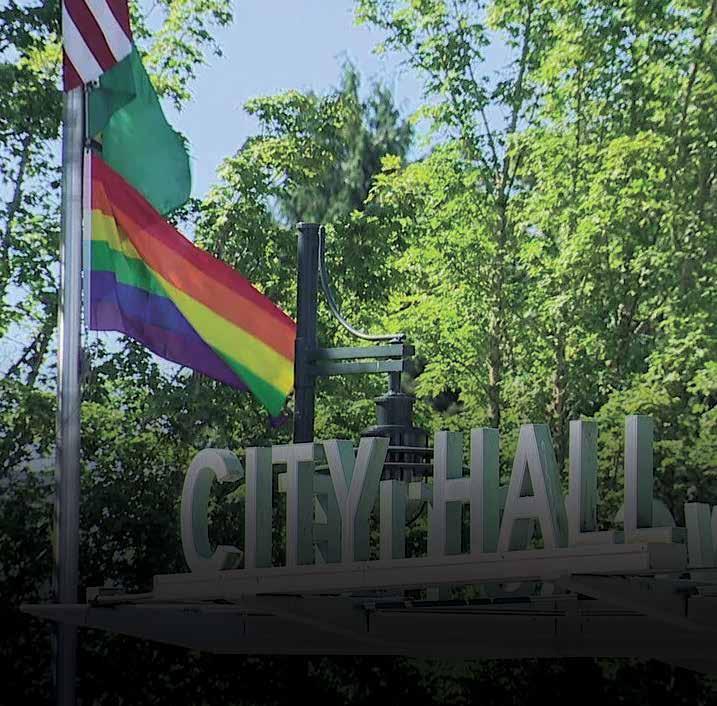
Newcastle raises Pride flag after strong opposition
BY HANNAH SAUNDERS
SGN CONTRIBUTING WRITER
Newcastle’s city council voted against raising the Pride flag earlier this month, whereupon several councilmembers and numerous community members — including LGBTQ+ youth and allies — pushed back against the decision. While they were met with intimidation tactics by those who were against the Pride flag and those who cited the god of Christianity, Queer love overcame all of it: Newcastle held a Pride celebration and the flag now flies above City Hall.
“I didn’t expect this to be sort of an issue that it became,” Councilmember Paul Charbonneau told the SGN. “I didn’t expect them to say all the things that they said.”
Charbonneau presented a motion to raise the Pride flag during a city council meeting on June 4. It was something the city had done for the past three years, and he wanted the city to take action to show residents that Newcastle is a welcoming community.
At that meeting, Mayor Robert Clark said the American flag, which already flies above City Hall, is the most unifying symbol in the world.

New era for the SGN
Renee Raketty succeeds Mike Schultz as publisher
BY MATT NAGLE SGN CONTRIBUTING WRITER
The staying power of the 50-year-old Seattle Gay News has been proven yet again. Effective July 1, longtime SGN writer and current editor Renee Raketty will be its new owner and publisher, following the departure of Mike Schultz, who is moving to California.
“I’m really honored to have the opportunity to fulfill this role as publisher,” Raketty said. “I have had a number of roles over the years at the SGN, so this paper has a profound place in my heart.
There is no higher privilege than to serve your own community and share their stories with the world.”
Raketty will be the third SGN owner since the passing of the newspaper’s longtime owner and publisher, George Bakan, on June 7, 2020. Upon his unexpected loss, Bakan’s daughter Angela Cragin inherited the paper and ran it primarily from her home in Eastern Washington, in order to continue her father’s legacy and save the SGN from closing. She also brought in a young and diverse crew of writers who contributed substantially more original reporting.









No pride to celebrate
by Larry Kramer
We have little to be proud of this Gay Pride Week.
One by one we are being picked off by the enemy.
I don’t think you’re going to like what I’m going to say. It’s the last time I am going to say it. I’m making a farewell appearance. I am not tired. I am certainly not suffering from burnout. I have a lot of piss and vinegar left in me — too much in fact. No, I’m not tired.
Not physically tired, at any rate. I am, of course, as are you, very tired of many things. I am tired of what they are doing to us. I am tired of what they aren’t doing for us. I am tired of seeing so many of my friends die — I’m exceptionally tired of that, as I know you are too.
I’m also tired of people coming up to me on the street and saying, “Thank you for what you’re doing and saying.” They mean it as a compliment, I know. But now I scream back, “Why aren’t you doing it and saying it too?” Why are there so few people out there screaming and yelling? You’re dying too!
They are killing us! We are being picked off one by one. Half the men reading this could be dead in five years, and you’re still sitting on your asses like weaklings and therefore we, the Gay community, are not strong enough and our organizations are not strong enough and we are going to die for it!
I have come to the terrible realization that I believe this Gay community of ours has a death wish and that we are going to die because we refuse to take responsibilities for our own lives.
Yes, most of all, I’m tired of you. I’m tired of the death wish of the Gay community. I’m tired of our colluding in our own genocide. I’m tired of your passivity in participating in your own genocide.
You do not have to have AIDS to acquire a system deficient and immune.
How many of you have given a thousand dollars or more at any one time to any Gay organization or Gay charity? Ten thousand?

(For the rich readers: One hundred thousand dollars? A million?)
How many of you have spent at least an hour a week volunteering for a Gay organization? Ten hours? […]
How many of you have written consistently or even irregularly to an elected official or testified to an official hearing on the subject of AIDS, or regarding treatment, or official lethargy in this city and state and country?
How many of you really trust the NIH is capable of coordinating research around a crisis of this scope?
How many of you even know what the NIH is, or how important it is in your life, and that your very own life is in its hands? You didn’t know that, did you? That your very own life is in the hands of an agency you don’t know anything about. […]
How many of you are willing to face up to the fact that the FDA is fucked up, the NIH is fucked up, the CDC is very fucked up — and that entering the seventh year of what is now a pandemic, the boys and girls running the show at these organizations have been unable to make whatever system they’re operating work?
How long are you prepared to wait for these systems to work? How long are you prepared to wait before our own AIDS organizations provide us with adequate information on available treatments? How many hours and days are you prepared to spend on the phone attempting, in vain, to find out what is going on where and how’s it doing and why can’t my dying friends get it immediately?
How many of you believe you have no responsibility to take action on any of these matters?
How many of you need to die or become infected before you feel you can take action on why every single branch of government in charge of AIDS, both local and federal, is dragging its ass?
What’s the number at which you can decide to stop just sitting quietly like the good little boys and girls we were all brought up to be and start taking rude, noisy, offensive political action?
It always amazes me when I tell people they have power, and they answer me, “Power?
Me? What power?” How can you be so conservative, dumb, and blind? You know what is going on better than anybody, and yet you are silent, you constantly, consistently, and continuously sit on your collective asses and refuse to use your power.
Your voice is your power! Your collective voices! Your group power! Your political power! Your names all strung together on one long list is your power. Your bank accounts are your power, if you weren’t all so devastating stingy when it comes to funding anything Gayer than a Halloween costume. Your bodies are your power, your living bodies all strung together in one long line that reaches across this country and could reach to the moon if we only let it.
You know that this country is not responding on a national political level or a local political level, and yet you sit by along with everyone else and watch our men being picked off one by one by one by one by one. No one is in charge of this pandemic, either in this city or this state or this country! It is as simple as that. And certainly no one who is compassionate and understanding and knowledgeable and efficient is even anywhere near the top of those who are in charge. Almost every person connected with running the AIDS show everywhere is second-rate. I have never come across a bigger assortment of the second-rate in my life. And you have silently and trustingly put your lives in their hands. You who are firstrate are silent. And we are going to die for that silence. […]
Don’t you ask yourselves quite often the Big Question: Why am I still alive? Untouched? At some point I did something the others did. How have I escaped?
Don’t you think that makes you obligated to repay God or fate or whomever or whatever, if only your conscience, for this miraculous fact: I am still alive. I must put back something into this world for my own life, which is worth a tremendous amount. By not putting back, you are saying that your lives are worth shit, and that we deserve to die, and that the deaths of all our friends and lovers have amounted to nothing.
I can’t believe in your heart of hearts you feel this way. I can’t believe you want to die. Do you?



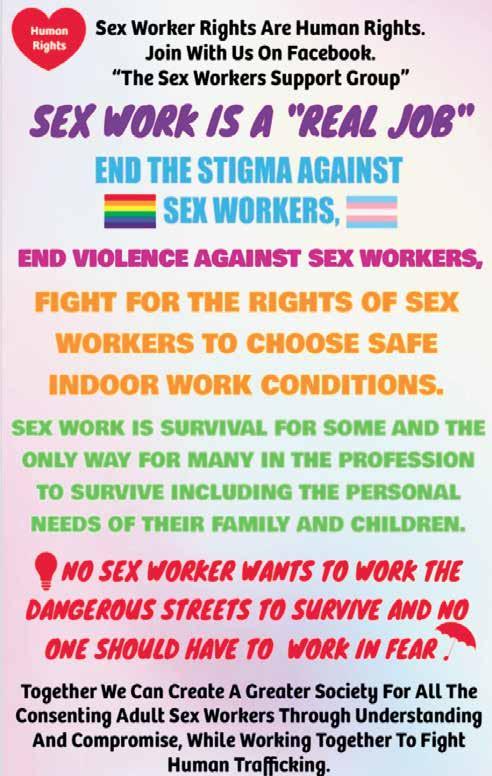
Diaz was assistant chief when the George Floyd protests unfolded, and by July of 2020, he was promoted to deputy chief. Chaos within the department, combined with making sure his children were maintaining positive social networks during this period of isolation, made Diaz feel like it wasn’t the right time to come out. He said he wrestled with that question for a while that year.
“There’s only been one major city [with] one Gay man that’s led … as a chief that I know of in the last ten years, if not longer,” Diaz said, citing Chris Magnus, a former chief at the Tucson Police Department. “It doesn’t happen. There are some females that do lead police departments as Lesbians, but again, it’s a rarity — it doesn’t happen all the time. As I’m going for the job as a chief, I’d been in conversations with different groups of people, and they’ve expressed their different struggles.”
Finding the right time
Diaz said his goal was to conduct his work with compassion and kindness, and he didn’t want people to use his Gay identity against him.
“People prey on your weaknesses,” Diaz told the SGN. “I’m not saying it was the right thing to do or the wrong thing. It was just something I felt like, ‘This is probably not the right time.’ And I tell people: is there any right time? I think the right time is when you’re ready for that time to come.”
Even though Diaz kept his identity private for a while, he said he never felt ashamed of it. His primary concern was his three children, and he knew coming out publicly wouldn’t have been easy for them back then, or even now. He was also questioning how coming out would impact his relationships and connections within the community as an out chief, and acknowledged how some people might not feel comfortable with that.
“I think we can all say, if you lose it, it’s not worth it to have it. But as a chief, I don’t have that luxury. I serve everybody,” Diaz said.
Diaz began serving as interim chief of SPD in August 2020. In September of 2022, Mayor Bruce Harrell appointed Diaz to serve as the permanent chief. The search for someone to fill that position, though, led Diaz to continue to grapple with coming out.
“If I were to come out during the chief search, [people would say,] ‘Are you only doing it because you’re in the chief search?’” Diaz said. “In my mind it was always, ‘I’m not being who I am.’ I think that was probably one of the hardest things to go through in this process — to never feel like you could just be you. When I decided I was no longer fearful, it was time for me to just be me.”
Coming out to his inner circle and family
Working alongside the LGBTQ+ community and communities of color was a focus of Diaz’s policing over the past 18 years of his career, he said, and not once did he ever contemplate his sexuality. He has friends who identify as LGBTQ+, and through conversations with them, he began to realize this is who he is, and to question why he didn’t recognize it earlier on.
“I’m learning to come to terms with how life moves you, and how it guides you, and sometimes you don’t have that control — sometimes you don’t know who you were at the very beginning,” Diaz said.
In 2001, Diaz had a Lesbian officer of 34 years at that time tell him that she thought he was Gay, he said. After coming out publicly, Diaz said this officer shared words of support. He told the SGN that sometimes people see things you don’t always see in yourself, that all lives are a journey, and that we don’t always see what’s right in front of us, even though others might.

Diaz came out to his inner circle about four to six months ago and spoke with Mayor Harrell about it four months ago, so as to prevent them from being caught off guard.
“When I was no longer in the position [of chief], it was kind of easy, because the weight of this was all off my shoulders,” Diaz said.
Diaz admitted he thought coming out would take a harder toll on his kids, but he was overwhelmed with their support.
“I was so impressed with their support, that they didn’t care who I was, and I love them for it,” Diaz said. “You always want to know, have I raised my kids right?”
Diaz’s 14-year-old told him that if people don’t like him for who he is as a Gay Latino man, then they can kick rocks. “I really appreciated them showing that love and support,” Diaz said.
Diaz chose to come out publicly on his children’s last day of school, because he didn’t want them to experience any bullying or rude comments from other students. Now, they’re on summer break, spending time with friends and playing soccer, baseball, and football.
“I”m very grateful for their strength, because you don’t know what the impact is on them,” Diaz said.
Is the SPD welcoming of openly Queer officers?
Overall, Diaz believes the SPD has been accepting of LGBTQ+ people but admitted that not everything has been accepted and that many have fought to ensure that the department advances Queer issues.
“I did have silence for a long time, in a sense of I wasn’t out, but I think that a lot of officers were like, ‘You’ve always been the one that supported all of us on LGBTQ issues,’” Diaz said.
Diaz said he’s currently employed by the Seattle Police Department but is focusing on project-based work with Mayor Harrell’s office. He brought up how the SPD has openly Queer officers that he describes as the “true heroes” of the department.
“They’ve had to deal with the hardships of going through a department, and sometimes individuals not being all right with them. Or, sometimes trying to get promoted and feeling like they didn’t have an advantage to being promoted,” Diaz said.
Allegations of predatory and discriminatory behavior
Four female SPD officers filed a claim on April 25 against the SPD and the City of Seattle for creating hostile work environments, and subjecting them to sexual discrimination and sexual harassment. The claim for $5 million accuses Diaz of engaging in discriminatory and predatory behavior.
Officer Judinna Gulpan, one of the claimants, said she experienced predatory behavior from Sgt. John O’Neil. Around October 2022, she was interviewed by Diaz and others, and landed a permanent role in the Public Affairs Unit.
The claim outlines gender discrimination and sexual harassment Gulpan allegedly experienced from O’Neil, and accuses him of impeding her chances of becoming sergeant because she did not show an interest in him, other than as a supervisor. In October the following year, Gulpan received an email stating she was eligible for a review for a promotion. When she reached out to O’Neil, he posted negative reviews of her, and she was passed over for the sergeant position, the claim states.
The claim also says that Diaz downplayed her concerns about O’Neil when she brought them forth. “Chief Diaz essentially rewarded and condoned Sgt. O’Neil’s behavior, even after he knew that he was a bully and had engaged in discriminatory and harassing behavior,” the claim states.
Diaz is also being accused of predatory behavior by Officer Valerie Carson, who claimed he paid special attention to her, and would talk to her at the end of her shifts, causing her to be late getting off work. The claim states that Diaz would talk about himself or his philosophy, rather than work, in these conversations.
Due to the lack of a gender-affirming changing room, Carson — depending on her daily assignments — would have to change from her uniform into civilian clothes. The claim said the entire staff knew she changed her clothes on a regular basis, and would alert her prior to walking past her cubicle to ensure they wouldn’t catch her in the midst of changing.
“Chief Diaz, on the other hand, would simply walk into Ms. Carson’s space without making an announcement, even though he knew she could be changing. Ms. Carson believes that Chief Diaz did this because he was hoping to catch her changing her clothes,” the claim states.
Diaz brought up allegations about grooming Carson. “That’s just not true. It’s just false,” he said.
The claim states on New Year’s Eve in 2020, Diaz asked Carson to drive with him around the city, and that she insisted on a detail.
“Ms. Carson was afraid that the Chief would perhaps make an advance at midnight when people traditionally share a kiss to bring in the new year. He relented and agreed to a detail. Nonetheless, Ms. Carson thought it was odd that the SPD Chief would want to go out alone with a female patrol officer on one of the busiest and hectic nights in the City without a security detail,” the claim states.
Diaz told the SGN that every New Year’s Eve, he takes photographs of fireworks displays, and that’s what he was doing that night.
“I didn’t ask her to go on a ride-along. I go, ‘Well, if you need anything, I’m always out,’ and I actually took photos,” Diaz said.
On another instance where Carson and Diaz were in the car together, according to the claim, the topic of her newly bought home popped up, and Carson noted how she needed her windows replaced. The claim says Diaz offered to replace the windows, unsolicited.
“The discussion is significant because, according to press reports, Chief Diaz offered to help Jamie Tompkins, SPD Chief of Staff, do some work at her house. It is also rumored that Chief Diaz hired Ms. Tompkins because they were having an affair. This conduct is arguable not coincidental,” states the claim.
Diaz shared his version of events with the SGN
“She said she had leaks in her roof and had to replace her windows. She was crying, so I said, ‘Well, if you need help then I can help you. It doesn’t take much to replace it,’ because this is what I did before I got this job. My dad was a plumber/contractor, so I fixed houses and did remodels,” Diaz said, adding how he went to former SPD Chief Carmen Best’s house to take a look at a backyard remodel.
The SGN could not confirm Diaz’s visit to Best’s house, or whether his father was a contractor.
“It’s my little safe haven of things to do,” Diaz said, mentioning how he helped a 90-year-old neighbor with plumbing issues but had zero interest in sleeping with her. “Those are the things that I’m having to address, but it didn’t matter whether I was Gay or not to address them. Coming out — that isn’t a big deal to it.”
Confident of vindication
One of the reason’s Diaz came out during this chapter of his life is because while there was litigation during his tenure as police chief, he was unable to speak out. When he was demoted from the position, he felt like he finally could.
“I’m confident that I will be vindicated and move on,” Diaz said. “Just because you’re a Gay man doesn’t mean that you can’t be a misogynist. I’m very aware of that, but I know who I am. I know how I treat people. I’ve worked in communities of color, I’ve worked in the LGBTQ community for 18 years. I know how I treat people, so this [coming out] has nothing to do with [the allegations].”
Diaz said he’s had one unfounded complaint in his first 26 years of his career, but about 12 within the last year.
“I made a couple of demotions, and that’s what happens sometimes. There’s a lot of scrutiny when it comes to leadership. People want to lead — I get it, but I can tell you I know how I treat [people] and how respectful I’ve always been ... Coming out as Gay doesn’t negate that,” Diaz said.
Moving forward
Diaz wants people to understand that no one knows what anyone else is going through in life, including lived experiences, hardships, and trauma.
“I want to see a world that’s accepting. You don’t even have to announce whether you’re Gay or not — just accepting of the world,” Diaz said.
For the last 18 years, Diaz was involved in many of Seattle’s Pride events, and he said he’s likely to continue that tradition.
“This feels a little bit weird of a month because I’m not in that role in the police department, so I’ve kept a little bit of a lower [profile], but that’s probably what my month will be about,” Diaz said.
Diaz said he will continue to work on special projects within Harrell’s office, but is open to the opportunity of becoming police chief in another city.

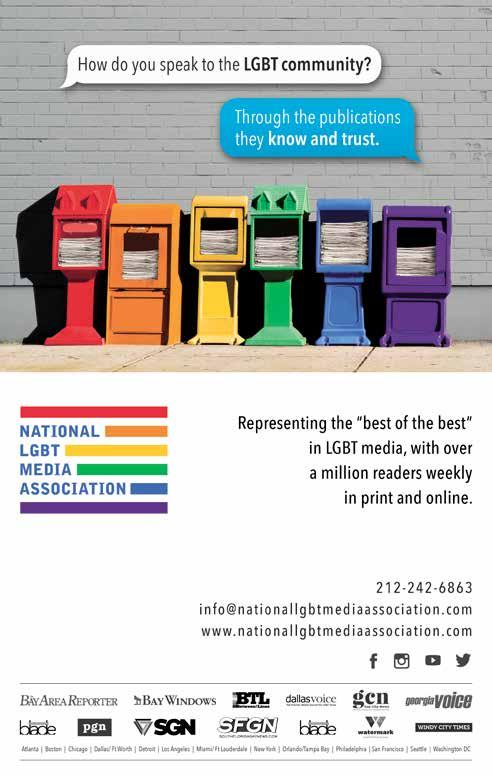




“She did a fantastic job of helping the newspaper get back on its feet, especially at the time when COVID was rampant and advertising dollars had basically dried up,” Raketty said. “She proved to be a very effective leader, and I know her personality really appealed to a lot of people in our community. I’m so grateful to Angela, and I’m sure George would be proud of her too.”
Raketty was instrumental in working with Cragin to keep the SGN on track. She wrote stories, assisted with editorial decision-making and helped secure a new SGN office on Capitol Hill.
Cragin stayed the course, but after three years of unexpectedly dedicating herself to this work, the mother of three was ready to focus back on her own family and career.
Gay ownership returns
Enter Mike Schultz, a successful accountant and businessman who has much experience in LGBTQ media, having published Stoneway News Northwest and Q View Northwest in Spokane (2007-2010), and Coastal Pride in Grays Harbor County. He added the Seattle Gay News to that list on Oct. 1, 2023.
Schultz was quite familiar with the SGN from having lived in Seattle during the 1980s. He said he recognized then how important the paper was, especially amid the devastation of the AIDS epidemic. The SGN was at the forefront of this turning point in Seattle’s LGBTQ community.
“Living here, that was my connection. It was going to the bars, or you read the Seattle Gay News to really know what was going on,” Schultz said in a 2023 Seattle Times story about taking ownership of the paper. “That was the beginning of the AIDS crisis. That stuck with me: its value and relevance and how it literally saved some people’s lives.”
For the second time, the SGN was saved when Schultz took ownership last year, something that Raketty found to be a true blessing.
“Like Angela, if it weren’t for Mike, we would not be here,” she said. “He applied a lot of practices that streamlined the way the business is run, and I am grateful to him for allowing me to retain all of those practices that he incorporated into the paper.”
Under his leadership, the SGN was elevated in numerous ways. For example, Schultz broadened its reach with new distribution sites in Spokane, Bellingham, and Ocean Shores; he upgraded the SGN ’s sales and marketing infrastructure; and he took on the ambitious task of creating an online archive of every issue of the SGN going back to its formative years in the mid1970s. (Schultz has generously ensured that the archives will continue to be available free of charge at http://SGN.org.)
When Schultz announced plans to relocate to Sacramento to be closer to his family, discussions began about the future of the paper. While the terms of the agreement have not been disclosed, Raketty described Schultz as “incredibly collaborative and forthcoming.”
Thus, Schultz’s Stratus Group LLC will officially pass the torch to Raketty’s Prism Pride Press LLC.
“Renee always brings to the table a depth of community and contributor engagement that comes from her experience, local roots, and understanding of the SGN ’s nuanced relevance and value,” Schultz said. “Her pivot from editor to publisher comes at exactly the right time, positioning the SGN to better adapt to the evolving dynamics of news and content distribution. Renee’s deep understanding of the paper’s mission and her knowledge of the LGBTQIA+ community position her to lead the SGN into an exciting future.”
Longtime connection
Raketty’s history with the SGN goes back to when she was in high school and became a noted outspoken activist, widely recognized
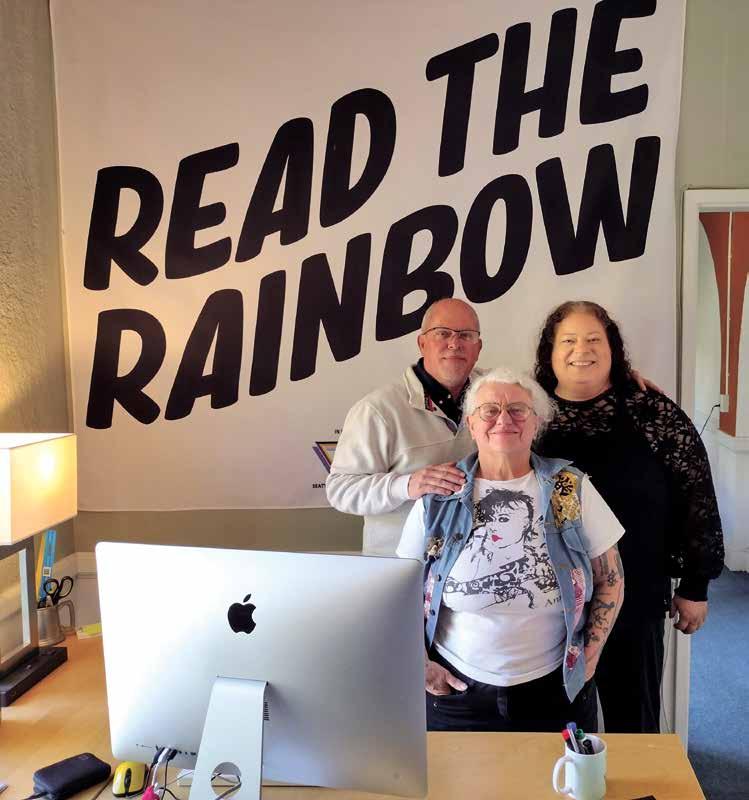
for her contributions to advancing LGBTQ equality in the Pacific Northwest. She testified in Olympia against school-based bullying, started a Gay-Straight Alliance at Newport High School in Bellevue (called S.A.F.E., for Supportive Acceptance for Everyone), and became the face of Seattle PFLAG on bus advertisements and billboards.
Interning with the American Friends Service Committee LGBTQ youth program brought opportunities for her to travel to different parts of the country and learn about efforts here and around the globe for promoting LGBTQ equality. Later, she would work as a youth alcohol and drug prevention specialist at Stonewall Recovery Services, and as Northwest regional director of Scouting for All and executive director of GLSEN Washington State. Her activism gained her many awards and certificates and much attention from the local media, including the SGN
Writing for the Seattle Gay Standard (2000–2001) exercised young Raketty’s burgeoning reporter talents. She began contributing to the Seattle Gay News in 2001, was hired as a staff writer, then was promoted to managing editor. In later years, when she wasn’t working at the SGN, she wrote for websites and always kept in touch with the newspaper that first opened doors for her journalistically.
Another first
Now that Raketty is taking her place among the SGN’s league of distinguished publishers, she brings something new, in that she is also its first Transgender publisher, just as she was its first Transgender editor.
“It’s incredibly important for our LGBTQ community to have another Transgender voice speaking their truth when Transgen-
der people here and across the country have faced some unprecedented attacks,” she said. “I continue to face overt and covert discrimination, so I know we have a long way to go. The path to our own equality is far from over, and I hope the SGN can be of assistance in bringing the community together to fight these challenges and win complete and full equality for all people.”
For the SGN staff, this ownership transition will be smooth and beneficial. Raketty has plans to improve the SGN website by adding content throughout the week, restoring the comprehensive community calendar, and continuing to connect people with resources, especially for those who are new to the community.
The print version itself will move from biweekly to monthly, and a weekly email newsletter will ensure that the SGN continues to be a regular and reliable news source as it has been historically. The print edition will be reimagined as a newsmagazine, with a newspaper approach similar to the SGN ’s popular special supplements. Readers can watch for the new format to debut on July 26 and on the last Friday of each month from then on.
While publications across the country are making the move from print to the internet, Raketty feels that it remains important to keep printing the SGN to connect with those in the community who relate to it as a print publication and as a way for everyone to stay informed without having to rely solely on computer or phone.
“We’ll be sharing more stories about the people in our community and diving deeper in ways that we weren’t able to do in the past,” she said. “Expect to see more thoughtful examination of issues that our community continues to face today.”
Above all, Raketty is well aware of the SGN ’s place in history as a source of truth about LGBTQ lives in a world that often turns to hateful stereotyping and outright untruths about Queer people and the struggles they face.
“We are a Supreme Court [case] away from seeing marriage equality overturned,” she said, “and we could potentially face a new president in the White House that associates with very conservative forces that oppose LGBTQ equality, especially targeting the Transgender community with the same lies and distortions they told about Queer people for decades.”
Raketty knows how to fight for what’s right, and it is her commitment to equality and what she learned along the way that make her such a perfect person to lead the SGN upon this, its 50-year anniversary.
She expressed much gratitude for three previous publishers — Bakan, Cragin, and Schultz — under whom she worked before becoming publisher herself.
“I’m incredibly blessed to have had such great mentors, especially George Bakan. Everyone had an important role to play in keeping the paper alive,” she said. “I hope to continue overcoming challenges and securing victories for our civil rights.
“ This paper has always belonged to the entire LGBTQ community in Seattle and the Pacific Northwest, and it will continue to do so for decades to come.”
Matt Nagle, who has previously served as SGN managing editor, will step into the role of editor on July 1, when Renee Raketty becomes the publisher.
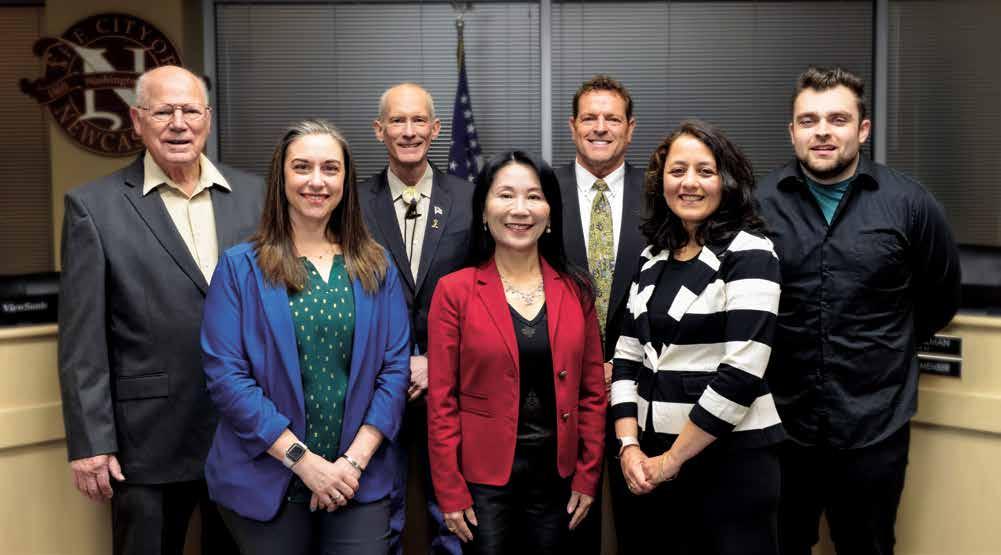
“That’s diverse enough for me. That includes everybody in the community. There’s no bodies left out under the American flag,” said Mayor Clark. “If we raise flags, we’ve got to raise everyone’s flag. What, are we going to raise Hamas’s flag in the city of Newcastle — or [the] MAGA flag? How about a Trump flag or an Antifa flag?”
Clark added how raising the Pride flag would divide the community, since there are people who are against it.
“They don’t speak up, because their house will be firebombed or something. Why should we exclude those people who don’t want to see a certain thing?” Clark asked.
Mayor Clark texts Charbonneau
Councilmember Charbonneau created a Facebook post following the June 4 meeting that stated his disappointment regarding the Pride flag decision. Mayor Clark reached out to him via text message and asked for him to remove the post, or add a disclaimer that it was Charbonneau’s opinion, not that of the entire city council.
“The[re] is no possible way to achieve unanimity on any cultural or social issue. There is no way for me to reach into indoctrinated and closed minds, so I expect backlash from some people. However, as a council member who just had a discussion on this, I would hope for more from you,” Mayor Clark texted. He added that anyone may participate or celebrate any issue or cause they support.
Councilmember Charbonneau responded that he was at his day job and would review the post at a later time, and added a disclaimer on the post stating that it was his own opinion.
“It would only take a second to remove the post until you can resolve it later. That would be the ethical thing to do,” Mayor Clark said.
Councilmember Charbonneau told the SGN he felt like the mayor was bullying him in an attempt to get him to remove the Facebook post in question.
Follow-up council meeting
The LGBTQ+ community and its allies turned out for a Pride celebration on June 18 — the day of another city council meeting,

which was more concerning than the last.
“The anti-Pride group waited right outside City Hall, because they knew we weren’t going to be there right away, and then they flooded the chambers,” Councilmember Charbonneau said, who added how the group was singing hymns as he entered the building. “They [those in favor of the Pride flag] were literally booed at public comment. I have never seen or heard of that at a city meeting.”
Some of those against raising the Pride flag said it isn’t inclusive of all people; others said LGBTQ+ people should “surrender” to god, while another person said the flag promotes pedophilia. Shortly after public comment kicked off, Councilmember Charbonneau placed a hand-sized Pride flag in his breast shirt pocket.
“Separation of church and state is not in the Constitution. I’m tired of hearing about separation of church and state. You could speak about whatever you want, and I encourage you do that,” Mayor Clark said.
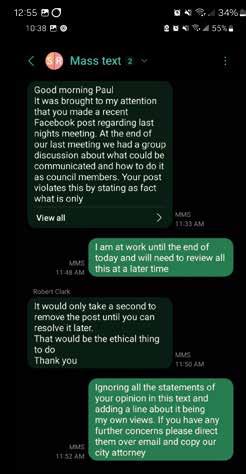
(The Establishment Clause of the First Amendment prohibits governments from making any law “respecting an establishment of religion.”)
A courageous 11-year-old middle schooler named Rosie spoke in front of the council and the anti-Pride attendees.
“Most of my friends are Gay or Nonbinary, but they have to hide that about them, because the other students do not see Gay and Nonbinary as a good thing and say “Gay” as an insult or a joke. So, I know that raising the Pride flag will help them understand that they’re not alone and that they are welcome here in Newcastle,” Rosie said.
The city council chose to revote on raising the Pride flag at the June 18 meeting. Councilmember Pratima Lakhotia flipped her vote to join Charbonneau and Councilmembers Sun Burford and Ariana Sherlock in support of flying the Pride flag above City Hall.
“That community is no stranger to having to fight for their rights,” Charbonneau said. “I ran for office as a Gen Z person because I wanted to see change in the world, and I have a responsibility to call out lies when I see it.”
Councilmember Burford replied to the SGN with words of support: “It is not just raising the Pride flag. It represents so much more than just a flag. It is symbolic of our city’s acceptance of diversity and inclusivity. Raising the Pride flag is a powerful symbol of acceptance, inclusivity, and support for the LGBTQ+ community. It’s a declaration that our community values diversity and stands against discrimination.
“By flying the flag, we acknowledge the struggles and triumphs of the LGBTQ+ community and reaffirm our commitment to equality and justice.
“As a councilwoman, I will continue to advocate for the rights and dignity of all individuals. I will work tirelessly to create a safe and welcoming environment for everyone, and I will strive to ensure that our community remains a place where all people can live authentically and proudly.
“It’s not just during June. Our support and solidarity with the LGBTQ+ community should never waver.”
Sherlock has a child who identifies as Nonbinary, and who has expressed — alongside their friends — how important Pride month is.
“It helps them feel more safe to just walk around and be themselves. A huge part of that feeling of safety comes from nonLGBTQIA+ community members like me, who support them and show solidarity in plain sight, like flying a Pride flag and wearing a rainbow,” Sherlock told the SGN
She added that she will continue to be an ally and listen to the LGBTQ+ community, but the comments she heard during the council meeting lead her to feel like the fight is not over.
“There were a lot of hurtful things… I know some of the council members said they didn’t hear anything hurtful, but it wasn’t hurtful to them — that’s why they didn’t hear anything hurtful,” Councilmember Sherlock said. “It’s not about them, in my opinion.”
The SGN reached out to Mayor Clark for comment: “I am very busy with my day job and will be unable to spare any time,” he said.


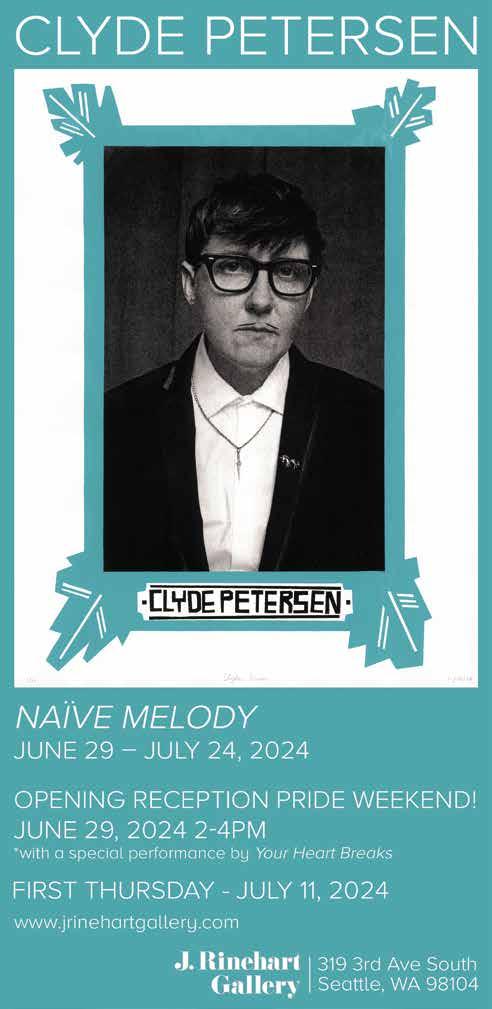
BY SHARON CUMBERLAND SGN CONTRIBUTING WRITER
A celebratory crowd of five hundred readers, scholars, and fans filled Town Hall on June 11 to hear local novelist and best seller Nicola Griffith talk about her medieval trilogy: Hild, Menewood, and Spear. She gave an eye-opening lecture about Queer women in early medieval Britain that asked questions about female sexuality and agency in a world dominated by male power. Judging by the close attention of the crowd, punctuated by laughter and applause, the audience found Griffith’s insights clever, funny, and grounded in historical facts.
Women in sixth-century Britain had very little power or freedom of movement and almost no voice. They are also largely absent from surviving historical documents and legends. Griffith was fascinated by this absence and described how she searched through the libraries of England and continental Europe for evidence that women had more power than we realized — as well as more Queer “follies” (sex! good times!) than historians might have imagined. Her research discoveries — found more in anecdotes and songs than in the master narratives of history — led to her first novel, Hild, about Saint Hilda of Whitby (c. 614–680).
Hild celebrates the life of a woman who was famous in her day for her wisdom,

energy, and independence of thought. Griffith said that her goal in writing about her was to show that the usual stories about kings and knights left out half the population of that era. By finding evidence of powerful women who were strong in their own right, Griffith also located clues that answered the question of whether Queer women existed and thrived in medieval England. Anecdotal
sources, such as songs and jokes, proved that such possibilities existed.
In the accounts of the historian Bede, who was born in Hild’s lifetime, Griffith discovered that Hild as a wise woman respected by the powerful men of her day. And as the abbess of a community of women, she was someone who might plausibly have found Queer sexuality familiar or even normal.
BY ALICE BLOCH
SGN CONTRIBUTING WRITER
In 2022, when COVID-19 had brought many well-established theater companies to the verge of collapse, Christie Zhao founded Yun Theatre, a bilingual (Mandarin and English), bicultural company dedicated to engaging with societal issues and fostering change. Asked where her bravery came from, Zhao now says, “I didn’t know what I was getting into! I knew nothing about producing theater and even less about starting and running a nonprofit.”
Yet Yun Theatre is now rehearsing its fourth fully staged production, June Is the First Fall, by playwright Yilong Liu. The play, co-directed by Zhao and David Le, is about a Gay Chinese man who returns to his family’s home in Hawai‘i ten years after escaping to New York. His return opens up memories and old wounds, revealing the struggles in his family to find love, acceptance, and belonging.
“It’s the most personal play we’ve done so far,” said Zhao. Le added, “We were moved to tears during the first rehearsal.”
Sebastian Wang, a student in the Professional Actor Training Program at the University of Washington, plays Don, the main role, both as a child and as a man. Wang’s gentle demeanor seems perfectly suited to this quiet character, whose conflicts are mostly internal and unspoken.
It’s basically a coming-out story, about the difficulties of being Gay in a Chinese immigrant family. These obstacles are still in the foreground for Queer immigrants and Queer children of immigrants. Said Le, “My parents accept Gay people in general, but if their kid was Gay, that’s another story.” Wang agreed: “When I go back to China and talk with my friends there, Gay life is still pretty much hidden.”
In the play, Don’s mother, who died many years earlier and appears in his

memories and dreams, speaks Mandarin and represents traditional Chinese culture, which Don still loves. His conflicts are dual: between Gay identity and traditional values, and between the West and the East.
Zhao said that one of the central questions addressed in the play is “Why is love in family so difficult and painful, when everyone is craving it?” Wang added, “In a family, we take each other for granted and don’t say certain things, but the love is there.”
Scenic designer Teia O’Malley was born and raised in Hawai‘i, and designed the

set and props for a production of this play when she was still in high school. She said that the themes of returning home, searching for home, and remembering home resonate powerfully for her and helped her design the house in which Don’s family has lived for a long time.
There will be postperformance talkbacks, programs about the intersection of Queer and Asian identities, and a board in the lobby where audience members can write their reactions to the play. “Every time we do a show, we want to engage with the community,” Zhao said.
Griffith, who characterizes herself as a “Queer cripple with a PhD,” presented her talk from a wheelchair on stage. She took the listeners through a discussion of why her novels preserve the ancient names of people and places despite a somewhat steep learning curve for readers. By using place names and key words as they occurred in Old Irish and Old English (for instance, “Cian” pronounced KEE-an; “scop” pronounced SHOW-p) she creates the same authenticity in language as she uses to represent the power and sexuality of early medieval women.
After her talk, Griffith answered a lively series of questions posed by María Bullón Fernández, a scholar of medieval literature at Seattle University and a member of the board of Humanities Washington, which sponsored the event. Griffiths also answered questions from the audience — though the last (“Was Hild a top?”) brought the house down and ended the event on a hilarious note.
The presentation was followed by a booksigning session in the Town Hall lobby hosted by Charlie’s Queer Books (463 36th Street). A long line of loyal fans and new kept Griffith signing all six of her books for an hour.
Find out more at https://nicolagriffith. com.
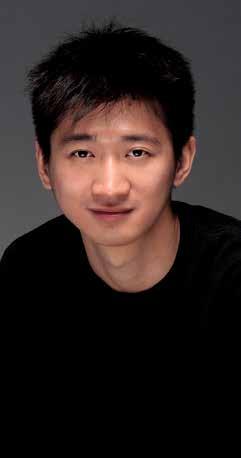
After interviewing members of the creative team, I felt great respect and admiration for their courage, determination, and sensitivity. I predict that June Is the First Fall will be very much worth seeing.
June Is the First Fall will run July 11-27 at the Theatre Off Jackson. For tickets and more information, visit https://yuntheatre.com.



















BY ALICE BLOCH SGN CONTRIBUTING WRITER
Oregon Shakespeare Festival Ashland, Oregon
Through October 13
The 2020s have been rough at the Oregon Shakespeare Festival (OSF). As a destination theater company far from urban centers, it suffered even more loss of audience during the COVID-19 pandemic than did the bigcity theaters.
Just when OSF was reestablishing live performances, summer wildfires shut down its venues for weeks at a time and destroyed the homes of a number of company members. In addition, many donors and subscribers withdrew their support over programming disagreements with Artistic Director Nataki Garrett, who resigned a year ago, exhausted by those battles and by racist death threats that made her afraid to leave her house. It was an ugly situation, and only a last-minute emergency fund drive made the 2023 season possible.
Under the leadership of a new artistic director, Tim Bond, OSF appears to be getting back on track. Bond, who was associate artistic director from 1996 to 2007, has long cultivated a good relationship with the Ashland community (he has a home in the area) and with the OSF audience. He understands that many attendees come back year after year to see the same highly skilled actors play a variety of roles, so he brought back longtime favorite cast members.
Audience numbers still aren’t up to pre-pandemic levels but have improved. Signs of necessary cost-cutting abound: minimalist sets, each shared by two plays; reduced educational offerings; several one-, two-, and three-person plays. But the productions are still top-notch, and the town of Ashland is still a delight.
Lizard Boy
Thomas Theatre
This adorable Gay musical has Seattle written all over it. It is set in Belltown and premiered at the Seattle Rep in 2015. Seattle-based Justin Huertas, who plays the main character (Trevor, the lizard boy), wrote the book, music, and lyrics, as well as creating art for the video projections.
Huertas and his buddies William A. Williams and Kiki deLohr have been performing and refining this play together for the past nine years, always under the direction of Brandon Ivie, and their opening performance at OSF demonstrated the many benefits of such a long-term collaboration. The three actors traded off musical instruments (I lost count of the number of different instruments they each played), backed one another up perfectly, and sang with the tight harmony that requires time to develop.
The premise (a childhood trauma turned Trevor green and scaly, making him so different from others that finding love seems impossible) and the plot (shy Trevor turns into a superhero, saves the world together with the “scary blonde” played by deLohr, and finds love with a wonderfully goofy guy played by Williams) sound far-fetched, but the play somehow works. Trevor’s message to the audience — “Your difference is your power” — resonates with all of us humans.
Lizard Boy is creative, original, funny, and moving. My companion and I agreed that the hilarious slippers worn by Williams were the best costume detail of the entire festival. Well done, costume designer Erik Andor!
Macbeth
Angus Bowmer Theatre
Directed by Evren Odcikin, the new OSF production of Shakespeare’s ever-

popular Macbeth is quite fabulous. It’s all about the three witches (Jennie Greenberry, Kate Hurster, and Amy Lizardo), who are nearly constantly onstage, accompanying the action with their expressive chants composed by T. Carlis Roberts and movement choreographed by Jon Rua. These “weird sisters” embody the eerie atmosphere of Northern European myth, combined with imagery from horror movies.
Now in his 27th season at OSF, Kevin Kenerly performed the title role with rare depth and subtlety. However, Erica Sullivan, usually one of my favorite actors, failed to develop her Lady Macbeth, who seemed unhinged from the very beginning, so her mad scene lacked emotional impact.
Several actors in smaller roles gave unusually memorable performances. David Kelly was excellent as the dignified King Duncan, then (after Macbeth murders Duncan) making a remarkable, dramatically effective transition (assisted by the witches) to the comic character of the Porter. Armando McClain was a splendid Banquo. All actors had admirably clear diction, so kudos to voice and text director Kate Wisniewski.
Born with Teeth
Angus Bowmer Theatre
This delicious two-man play by Liz Duffy Adams, directed by Rob Melrose, imagines how a collaboration between William Shakespeare and Christopher Marlowe might have gone. Adams got this idea when computer analysis of Shakespeare’s texts led to the finding that the two might have collaborated on the Henry VI plays. Adams was off and running, and the result couldn’t be more fun.
The back room of a tavern becomes the no-exit setting in which Will (Bradley James Tejeda) and Kit (Alex Purcell) bicker, flirt, and finally admit they love each other (right before Kit is killed as a result of his side hustle as a spy in the court of Queen Elizabeth I). Tejeda and Purcell delivered superb performances, juggling the play’s rapid-fire dialogue without dropping a line.
Adams’s text is extremely dense, full of allusions to the works of Shakespeare and Marlowe, the history of their time, and their life stories. Her use of language is exciting and nearly impossible to grasp completely in one sitting. Both my companion and I felt that we would have liked to see this play twice and that we wanted to read it. Fortunately, copies are available in the newly reopened OSF gift shop.
Much Ado About Nothing
Allen Elizabethan Theatre
This Shakespeare romantic comedy that almost becomes a tragedy is a feast for the ears, with much witty repartee between the principal characters, Beatrice (Amy Kim Waschke) and Benedick (John Tufts). These two pretend to dislike each other, but they are clearly in love; scheming by their friends finally forces them to admit it.
The second love story, between Beatrice’s cousin Hero (Ava Mingo) and Count Claudio (Bradley James Tejeda), is problematic: the villainous Don John (Christian Denzel Bufford) sets up a scene that convinces Claudio of Hero’s infidelity. Innocent Hero is spurned at the altar, and both Claudio and Hero’s father (Leontes, ably played by Al Espinosa) heap insults and threats upon her. She faints and is thought dead. Deputies of Constable Dogberry (played by the comic genius Rex Young) discover the truth. Hero is exonerated and immediately marries Claudio and forgives Leontes.
In every previous production I’ve seen, the Hero-and-Claudius story is played as written, and the audience is left troubled and unsatisfied. How can Hero marry someone who has treated her so horribly? How can she instantly forgive her father for joining forces with Claudio?
Director Miriam Laube came up with an ingenious solution to this problem: she wrote lyrics for Hero to sing at the end of the play. This song restores Hero’s dignity and makes the plot open-ended.
Laube also increases the audience’s enjoyment by adding a number of other songs and several dance sequences.
The result is an unusually physical production of this wordy play. Bufford and Lopez were revealed to have beautiful singing voices, and Lopez and Espinoza excelled in a graceful dance number.
Both Tufts and Waschke have a long history at OSF, and watching them play smart characters matching wits was a treat. That Tufts has an exceptional gift for physical comedy is no surprise to anyone who has seen him in other shows. In the midst of the mostly serious second half of the play, he and Young delivered welcome laughter.
Jane Eyre
Allen Elizabethan Theatre
Elizabeth Williamson’s adaptation of Charlotte Brontë’s classic novel is faithful to the original, and director Dawn Monique Williams has created an equally faithful production and cast it well. Jennie Greenberry conveys the title character’s vulnerability and strength. Armando McClain makes Mr. Rochester gentler and funnier than you might expect if you’ve seen Orson Welles’s interpretation of the role.
Scenes between Jane and Rochester crackle with energy, as does the ensemble work by other cast members who have shared the OSF stage many times: Kate Hurster, Al Espinosa, Caroline Shaffer, Tyrone Wilson, and Amy Lizardo. On opening night, their pleasure in working together was evident. Newcomer Thilini Dissanayake gave a charming performance as Jane’s pupil Adele.
If the enthusiastic audience I witnessed was any indication, this show will sell out many times over the season. The applause and shouts of approval that erupted when Jane spoke up for herself made me think that many in the audience hadn’t read Brontë’s novel. I bet this production will change that.
Virgins to Villains:
My Journey with Shakespeare’s Women
Thomas Theatre
This one-woman show, created and performed by Robin Goodrin Nordli and directed by Penny Metropulos, tells the story of Nordli’s life and career, and of the many roles she has played (in Shakespeare plays alone, “51 female roles, 29 male roles, and two…airy spirits,” and at OSF alone, 76 roles). I have yet to see her take on a role she couldn’t perform brilliantly, and her performance as herself is as good as any. What I found most impressive was her ability to jump into and out of character in an instant. Her narrative is appealing and might well inspire audience members to “go for the car,” in the lingo Nordli remembers from her very first role: as a contestant on the TV show The Price Is Right
Coming up next: Coriolanus and Behfarmaheen (If You Please)
Thomas Theatre
OSF Associate Artistic Director Rosa Joshi, co-founder of the Seattle-based Upstart Crow Collective, will direct an allwomen production of Shakespeare’s Coriolanus. It will use a modern verse translation by Sean San José, commissioned by the OSF Play On program. Coriolanus opens on July 23.
Behfarmaheen (If You Please), opening on July 31, is a one-man show created and performed by Barzin Akhavan and directed by Desdemona Chang. An autobiographical account of immigration from Iran to the United States, the play uses theatrical techniques from ancient Iran to tell a modern story.
For more information and to purchase tickets, visit https://osfashland.org.


BY SARA MICHELLE FETTERS SGN STAFF WRITER
I’ve been a big fan of critics, academics, and historians Willow Catelyn Maclay and Caden Mark Gardner for over a decade. I discovered both writers on the social media platform formerly known as Twitter, where the pair’s humorous and perceptive tweets about cinema — notably Trans experiences and expressions — unsurprisingly caught my attention.
This led me to the duo’s groundbreaking “Body Talk: Conversations on Transgender Cinema” collection. Basically transcribed conversations, the ten-part series (the last installment was uploaded on January 9, 2022) was a fantastical look at a variety of titles ranging from The Silence of the Lambs to The Matrix Resurrections through the lens of two best friends who just so happen to also be Trans film critics. Witty, informative, insightful, and infuriating (but in a good way), “Body Talk” is a constant thing of beauty, and directly inspired my “1,001 Great Films” series published in 2021 by the Seattle Gay News
Now Maclay and Gardner are back with their most ambitious joint project yet. To be released July 9, Corpses, Fools and Monsters: The History and Future of Transness in Cinema is a bold journey though over a century of cinema and is centered on celluloid depictions of transness. From the silent era to the works of Lana and Lilly Wachowski and to all points in between (and beyond), the book attempts to shine a spotlight on Trans representation — and hopefully Trans liberation — much in the same way author Vito Russo did for the Gay and Lesbian community with the publication of The Celluloid Closet: Homosexuality in the Movies back in 1987.
It’s a daunting task, but if their individual works and the “Body Talk” series are any indication, Maclay and Gardner are up to the task. I sat down with the authors over Zoom to briefly discuss Corpses, Fools and Monsters, their working relationship, and the current state of Trans representation in cinema (and in the world at large). Here are the edited highlights of our wide-ranging conversation.
Sara Michelle Fetters: You two have worked together talking about gender identity and Trans issues in cinema for years now, most notably with your outstanding “Body Talk” series. Where did the idea for this book start? Was it there? When did you know that you could actually put all this together?
Caden Mark Gardner: I think I remember it occurring on the website formerly known as Twitter. We basically made a part joke/ part manifestation that we should write a book about this, because we know stuff and other people don’t. At that same point, it was either very early on in our “Body Talk” dialogues or even predating that, but I think we just wanted to get into the weeds of “transness” on screen and also trying to find anything that might be considered worth revisiting.
But, at the same time, I don’t think either of us really had any real inkling of the kind of rabbit hole we would dive into for the last few years.
Willow Catelyn Maclay: Yeah. We were doing these series of transcribed conversations called “Body Talk,” which is kind of how both of us got our name out there in the broader community of film criticism. We had both written a little bit before then, but “Body Talk” helped us get our foot in the door at a lot of places. We were opening up


this new window, I guess, for people who are interested in film to kind of learn about Trans representation from a Trans perspective. All of these people in film criticism and cinephiles and our following on social media… were reading these dialogues that we were having about movies like Boys Don’t Cry and The Silence of the Lambs
Then it just snowballed from there. We just started joking, “Should we turn this into a book?” It kind of perfectly coalesced into this moment where the person who offered us a book contract at Repeater Publishing, Carl Neville, was reading “Body Talk” and was like, “I do think this could maybe be turned into something. Do you want to give it a try?”
Everything kind of went from there. Then the pandemic happened, and we didn’t have anything to do except sit around and watch movies for this book.
SMF: That “Body Talk” series was one of my chief inspirations when the Seattle Gay News came to me and asked me to do a “1001 Great Films” series during the
pandemic. I felt like I could talk about my own Trans journey and how that related to my cinematic favorites, and I could incorporate both those things into this massive, impossible 10-part series. I guess what I’m trying to say is, I love your “Body Talk” series. If people don’t know about it, they need to just go check it out. It’s essential.
WCM: It’s so interesting that “Body Talk” is kind of this thing for our career, but we didn’t actually do that many. We’ve done what, Caden, like 10 maybe?
CMG: Yeah, it’s wild that people reference [“Body Talk”] to us, because we’ve maybe only done it a couple of times in the past few years. It’s so wild and it’s so surreal. I was like, oh, people have read our work. We’re perceived. Oh my god. [laughs]
SMF: Well, people have read your work, though. Both of you have done so much stuff for a variety of publications. Whether it’s the Village Voice, the Criterion Collection… so many I can’t even list them all.
When you look at that body of work and then you compare it to this book, how did all of that writing that you’ve been doing for these publications, streaming services, and physical media distributors, plus your own sites, come into play?
WCM: I think that doing all of that work helped prepare us to write this book, because I think Caden and I are both critics who come at movies from a research perspective. We never write something just to write it. We’re always looking at something deeper within culture or within the film itself.
Caden wrote a wonderful piece about The Monkeys for the Criterion Collection, which I think honestly is maybe the clearest blueprint of what this book actually looks and feels like, but from a Trans perspective. I think all of that work helped prep us for this.
We had our people along the way that we’ve worked with who have made us better writers. Like Michael Koresky at Reverse Shot. I think this is just the culminating moment for us, where all the work that we’ve done in the past has been building to this book.
CMG: I was approached to write about Disclosure [the 2020 Netflix documentary on Trans cinema], which I didn’t like at all. I think looking more into how Trans people from the past might’ve reacted …and how there’s this sort of digital footprint now with stuff like the Digital Transgender Archive is a more interesting thing to look at. That was actually how I got my foot in the door writing for the Criterion Collection.
I would say that that piece is a notable supplement for anyone to look at, because I don’t think the book would exist as it does without that Digital Transgender Archive. I know there are many Twitter and Instagram accounts that basically source from there. But I tend to be a deep diver. I think I’ve referred to looking at a lot of the stuff we cover as almost dumpster diving, because you can find all kinds of treasures and trinkets and things that might be worth reevaluating. It’s fun. Exhausting, but fun.
In terms of writing, I think we both come from places of liking many things high and low, and I think that’s a perfect approach to have, especially when tackling this particular topic. We’ve seen transness be a sideshow act, but also a very stone-cold, serious-issue movie topic or a serious medical or educational documentary topic. We’re seeing all these various frameworks of Trans identity presented or even coded in a certain way. I think our passions as just general cinephiles who have these various perspectives and experiences with cinema [means] we don’t go in approaching things in a prescriptive way of saying, ‘This is bad, this is good, this is how you fix it.’ These can be compromised works, these can be imperfect works, but there still might be something worth talking about.
SMF: You’re dealing with essentially a century of cinema. Where do you even begin when you tackle something like this?
WCM: If Caden and I both didn’t love movies to the deepest core of our being, this wouldn’t be possible. Because I think that it’s not just that we were looking at the obvious images from the history of transness, whether that be The Matrix or The
Silence of the Lambs or The Crying Game or whatever. We went all the way back and tried to find instances of transness dating back to when cinema first started. I think that our broader knowledge of cinema that we already had as cinephiles kind of informed us of where to look and where to go. We found instances of transness in films dating back as far as 1907. But in order to fully realize this, you do have to have a polymorphous cinephilia, where you’re kind of looking at everything. This put us on the right path. Then take into account what we were researching, though, whether that be through the Digital Transgender Archive or through zines or whatever. We kind of knew which films we were going to look at and which films were going to be available, but we also did have some help too. I should shout out Elizabeth Purcell, who pointed us in the direction of a bunch films that we hadn’t previously heard of that did end up being in the book in a serious way.
CMG: While we definitely get into the silent era, we often talk about LGBT rights in a pre-Stonewall/post-Stonewall sense. I would say the history of this book is a very “pre-Jorgensen/post-Jorgensen” thing, because of how Christine Jorgensen became this worldwide phenomenon and how that basically almost gave a blueprint for many narratives and how that informed a lot of popular culture, both high and low. Yeah, definitely shout out to Elizabeth Purcell. Elena Gorfinkel was also a pretty outstanding reference point in just giving [us] titles of things that were kind of in the “disregarded” historical pile of mondo films and exploitation. One was I Was a Man. That’s actually a Trans woman autobiopic — that’s the best way I can describe it, but it’s quite an extraordinary object.
I think what we learned in looking through this history is that stuff was there — it just wasn’t always widely seen. It wasn’t something that would play at your neighborhood drive-in or multiplex. But these films were out there, and some of them even had considerable funding.
I think an important part of telling the history in this book was also outlining and contextualizing Trans figures, be it Jorgensen, Virginia Prince, Reed Erickson — a bunch of people through the ages who not only had influence but in some cases had a lot of money that helped actually push forward many cultural artifacts that we still look at today.
SMF: Timing is always everything, but it’s interesting to me that this book is coming out right when… Trans existence seems to be at the center of almost every social and political conversation. It’s almost like Trans people just suddenly appeared out of nowhere, as if the fairy godmothers from Cinderella just bibbity-bobbity-booped us out. Was it important to set that record — please excuse me for using this particular word — a little bit straight?
CMG: [laughs] It’s definitely important to underline that we’ve been here since the beginning. When you think of people who fit into gender-nonconforming categories, that’s existed since the beginning of time. But as far as the more medical definition, yes, we’ve been here for quite a while. But I think what we importantly present in the book is that we’ve often been in this almost circular or cyclical situation, where we make this progress, we have this visibility, we have these new pioneer faces, whether they’re Wendy Carlos or Jan Morris, but then something terrible happens, where the backlash overwhelms us. We all go back into the closet, so to speak, or we have to go into hiding for self-preservation. We kind of track that through the decades in talking about… both the cultural impact of these movies and the movies themselves. But, yeah, it’s quite a thing to have [the book] be out now in an election year. It’s also quite something to have this come
out at what we both consider a real high point in Trans authorship and a lot of Trans media work and cultural production. It’s a very overwhelming feeling of many emotions and many senses.
WCM: I just want to add one thing. The structure of this book is not so much only about the films themselves but also about the story of Trans people in the United States trying to fully express themselves socially and medically, and to live their lives. The narrative path of this book is such that you’re witnessing a kind of upand-down experience of Trans film images, Trans cinema, whatever you want to call it, struggling to be born. You’re seeing it grow and then fade, and then grow and then fade. It’s a really knotty experience.
What I’m hoping that people will take away from this book is that we have been trying to exist for as long as movies have. We’ve always been in movies, and we will be going forward, whether those films are highly visible or something that’s part of a more hidden archive — which is a phrase that people have been using with this book, referring to Caden and me, maybe unlocking some sort of hidden archive about Trans images.
But we’re hoping with this book that people will take that narrative from it, and also [that we] shine a light on the fact that Trans people have always been in cinema, from the very beginning, and therefore, have always been in society as well.
SMF: What I love about your writing is that you each clearly come from an academic perspective, but you’re still having fun. That comes across in almost everything that you write. How do you do that? Even when you don’t necessarily like a film, I still feel like you’re having a good time putting pen to paper and getting those words out there for people to read.
WCM: I think it helps that both Caden and I came from blue-collar backgrounds. This was something that we kind of birthed ourselves, to use an awkward phrase.
“Body Talk” started as something that we just uploaded on WordPress. It was never intended to be some sort of dissertation. We’ve always come from a place of [being] film lovers first and academics second, and I think that we’ve never lost track of that. We don’t want to alienate anyone with our writing.
Obviously, we’re coming at this from an intelligent place, and early reviews of our book have referred to it as academic, but in a way that is easily readable. It’s academic, but not at the expense of it being —
CMG: Homework.
WCM: Yes. Homework. Exactly, Caden. We don’t want to alienate anyone with what we’re doing. We never want to lose track of someone who is maybe 14, 15, 16 and doesn’t have all the answers but maybe is reading about films made by Trans people for the first time. Maybe they’re reading us. We don’t want to be in a situation where we want to seem like we’re above them.
CMG: I think from our own experiences and having difficulty often having access to a lot of these works, when we were teenagers or in our early twenties and figuring out our gender stuff… I definitely feel like we always have trained ourselves and have worked ourselves to be accessible reading.
But there’s a part of me that wants to outright reject academia, because I often think it’s all warped, in many ways, even as much as I admire the work of many academics, especially Trans academics like Susan Stryker and such.
I think there’s a kind of urgency with the fact that there often seems to be so much at stake for Trans visibility, Trans liberation, and Trans autonomy that it would be useless to try to use a bunch of $10 words when we can just say, “This is what we see, this is how we react, this is why it’s meaningful to us.”
I feel like we put our blood, sweat, and tears into a lot of this book. As Willow said, I would say we’re both very proletariat without necessarily coming off as these aloof academics from the ivory tower. It’s important to us that talking about these
movies invites more dialogue and more eyes to [them], and it would be useless to try to act and write it as if there needs to be some type of privileges involved in that.
A notable response we’ve been getting is, “I want to watch so many of these movies, although I can’t see them all.” Some of that is tied up in academia. Some of that is tied up in good old-fashioned Hollywood rights nightmares. I think us stressing that we go both high and low [with the films] was based on what we were able to see. Some titles were more difficult than others to find.
Although, it’s interesting to see the evolution of some of these titles through the years. Some have been able to be restored or reintroduced. It’s interesting to see the evolution of where we started and how it’s all culminating now.
SMF: I do have to ask, what was the most fun part of putting this book together? What made you guys smile the most as you were finishing it up?
CMG: We did a lot of collaborative writing, but I think there were sections we wrote by ourselves, either because only one of us had seen something maybe or because of time. There was a fun thing where I basically wrote a whole section on Dr. Jekyll and Sister Hyde and placing it alongside an early Trans narrative called I Want What I Want. I felt insane while writing it, and I kept waiting for people to say, “You’re nuts.” I was like, this is crazy, but it’s also cool. It turns out, based on early feedback, readers got what I was doing. So that was fun.
WCM: Following down the same place as Caden, we did kind of trade off sections. That was the best way for us to approach this, so that we could get it done in a timely fashion, where I would be like, ‘I’ll write about this film. You write about that film. We’ll meet in the middle and edit each other afterward.’
I think the most fun I had writing in this entire book was maybe when I was trying to finally unpack my thesis of why David Cronenberg’s films are essentially attached to a Trans visual language that we can all identify with. There’s this prolonged section in the book that’s like, I don’t know, 20, 25 pages on David Cronenberg and a few other films that are notable that Trans cinephiles have been gravitating to in recent years. That was really fun to piece together. I think, with my own interest in horror, it just came out. The prose was easy. It was really fun to write. It was really lovely to get into the nuts and bolts of why Cronenberg’s visual language is what it is, and even finding instances where Cronenberg either directly or indirectly underlines the fact that there is a transness about his cinema. There are a few revelations in that chapter that I think readers are going to be surprised by, and I’m excited to hear what they think of it.
SMF: We talked about the political aspect. But from a more surreal and maybe also fun aspect, your book is coming out at a time where we have an explosion of Trans cinema that is made by Trans directors that are being celebrated by cis film critics. How weird is that? Or is it weird? I honestly can’t figure that one out myself.
CMG: It’s interesting to note how when I was looking at stuff from the ’90s and the 2000s, where you were seeing actual efforts made to have Trans film spaces such as — this will probably come off dirty when I say it, but that’s what it was called at the time — Tranny Fest, which was an early film festival in 2000. I remember it was the academic Jack Halberstam who called it, stuck in the wake of Boys Don’t Cry, an “explosion of Transgender films,”
But now we’re seeing, and as Willow states, this kind of evolution of Trans cinema, of not just our existence being distilled into imagery but how Trans performance and embodiment is now something we can claim as our own, as well as Trans authorship in these other movies.
Like, The People’s Joker is obviously something that, the moment it had that kind of whole legal quarrel and very dramatic cease-and-desist moment at the Toronto
Film Festival, that felt like it was this mainstream breakthrough all by itself just for that. And then we actually see it and it’s an incredible film.
We also see how Jane Schoenbrun’s I Saw the TV Glow has this very interesting array of reactions. Willow might be able to get more into this, but…every Trans person I know has had a reaction to that movie in some sort of way. Or they are hearing these secondhand stories of people they know having these very almost spiritual reckonings with themselves after watching that movie in relation to their gender identity. Whereas [for] a lot of cis critics, even if they like it, the Trans aspect might fly over their heads. It’s very interesting to see the varied reactions to this wave of movies.
WCM: The cisgender reaction to I Saw The TV Glow has really put to bed this kind of inside joke among Trans people where we assume there’s no such thing as cis people. There are certainly cis people, because cis people look at this movie — it’s not everyone obviously, but I’ve seen a lot of cis critics latch onto the nostalgia angle or the “this actually does feel like the 1990s” angle. And it does.
But I do think that Trans people are having a more specific reaction to the film. Credit to A24: they put the film in front of Trans critics before it came out. We both saw it early. We had a chance, along with a bunch of other Trans critics, to shape how the discussion of this film would play out. It’s kind of night and day to how a Trans film would’ve come out before we started this book. One sort of lightning rod moment was Tangerine. Cis critics at the time were misgendering actors in reviews. That was just 10 years ago, and that would be unheard of today. So, we are seeing progress made, but I do think it’s very important for cis critics to read Trans critics on movies that are ostensibly about transness, because we have a different, more specific response to these types of movies.
SMF: For Trans or Trans-questioning or genderqueer people who pick up the book: what do you hope their reactions to it are? Same question for cis readers. CMG: For cis readers, I just hope that they are able to expand their vocabulary and also their reference points beyond, say, movies that were made after 1999. Some of these movies that made big impressions, obviously, predated that, but [we hope people just have] a better idea of how transphobia often drove and determined a lot of the ways in which a film was received and also how a film was remembered.
Think of how Ed Wood’s Glen or Glenda was often placed in the worst-film-evermade category. It just feels, one, not even close to the worst film he’s ever made. Second, you think of how bold that movie is and the huge swings it takes. It’s so earnest. I’m not telling people to no longer think it doesn’t have funny moments or anything, but look into what this film’s reference point is, because this didn’t just come out and make these reference points out of nowhere. What was going on in the world at the time? Many Trans movies had a “ripped from the headlines” quality to them.
As far as Trans and gender-nonconforming people, there’s definitely a deeper cinematic well out there than we were often led to believe. You have to go beyond the Hollywood filmmaking mode. You sometimes have to go into watching movies with subtitles. You might have to go into the silent era. But there’s stuff there that is definitely worth checking out. A lot of stuff.
WCM: I would just add onto that: I hope that when Trans people read this book, they feel a fuller realization of their history, especially if they love movies. I hope that they realize that if they go rummaging through the dustbins of history, they will find themselves.
Corpses, Fools and Monsters: The History and Future of Transness in Cinema will be released digitally and at bookstores everywhere on July 9.
BY LINDSEY ANDERSON SGN STAFF WRITER
Rachel Runya Katz has always been an avid reader, but her love affair with romance novels kicked into high gear during the pandemic. “I grew up reading. My parents would joke that a nuclear bomb would go off, and I wouldn’t notice,” she said.
“I always loved reading. I always wanted to write a book, but I didn’t take that seriously. [In] early COVID, I started reading more romance. That was partially because the romance genre had started publishing more diverse titles. As I read a ton, I naturally came up with an idea, and I just started writing it.”
That first book became Thank You for Sharing, a childhood friends-to-lovers romance featuring a Bisexual, Black, Jewish lead character. Readers loved Runya Katz’s leads, not just for being messy, BIPOC, and Jewish, but for their ability to convey the exhaustion of working through trauma as a twentysomething.
Runya Katz sold Thank You for Sharing on a two-book deal. While writing it, she had plenty of time and energy to feel creative and enjoy the process. However, when it came time to submit her second novel, Whenever You’re Ready, it was more necessary to stick to a rigid writing schedule. “It required a certain level of discipline that can take some of the fun out of it. I had this detailed outline, [while] my first book I just wrote. I figured out how to make it fun, but that part was difficult for me,” she said in an interview with the SGN
One of the ways she made writing Whenever You’re Ready more fun was by leaning into tropes and situations that can play out differently for a Sapphic couple than a male/female pairing. “I love writing bits where people are in fights. I think it’s fun,” Runya Katz revealed. “I think there’s a little bit of what one of my early readers described as a ‘Bisexual jealousy scene.’ There’s a lot of tension.

“That’s the fun thing about writing a Sapphic romance. I can get the ick when a man is acting jealous — I know it’s natural and can be written well — but for me, personally, sometimes I’ll see that on the page and it’s ‘Yuck! Go away!’ When it’s a woman doing it, though, this is fun to play with.”
Road-tripping through history and grief
A slow-burn friend-to-lovers, Whenever You’re Ready is an emotional yet fun summer road-trip story about identity, heritage, and dealing with grief. The story was inspired by several experiences Runya Katz faced in her twenties.
“It’s set on a road trip. They go on a Southern Jewish history road trip… In the fall of 2019, I went on one — it was called ‘Shalom Y’all,’ and it was all Jews in their twenties,” she said. “It was an interesting experience, because I was raised in the

Pacific Northwest, and so it’s a much newer part of the country, whereas Charleston and Savannah existed before [the United States] existed. In terms of anything that isn’t Indigenous history, that’s as old as it gets.”
While touring the South, Runya Katz encountered several Jewish places of worship that, unlike most synagogues in the north, were built by slaves. “I think it was interesting to me because it’s not a part of Jewish history that’s [often] focused on,” she said.
When thinking about her second book, she wanted to revisit the idea of a conflicted heritage by exploring the story through the perspective of a character reexamining the dynamics of her ancestors.
The book also centers on grief, an experience Runya Katz encountered early in her twenties. “This was supposed to be a road trip that [the character was] going to go on with their best friend, who passed away, and I lost my best friend to cancer when she was 20,” she said. “I aged her up a bit in this book, but I wanted to explore grief over the death of a young person. It’s such a specific
thing. There are a lot of books about grief, but a lot of the romance books I’ve read that feature grief are either about a parent or a grandparent or a previous spouse who had died, but I wanted it to be a friend who was like family but…also super young.”
Runya Katz likes to describe her books as “rom-traum-coms.” With a clever wit and a knack for breaking into the emotional heart of complex issues, Whenever You’re Ready will have readers laughing, crying, and swooning all in one chapter.
“All of these things in real life are wrapped up in one another,” she said. “I don’t think that you can have your humor without your trauma informing it, and I don’t think you can have love and happiness without sadness and pain.”
Whenever You’re Ready hits shelves on September 10, 2024. Until then, readers can check out Thank You for Sharing at Elliott Bay Book Company, Third Place Books, and Charlie’s Queer Books











